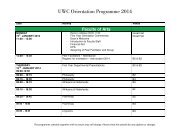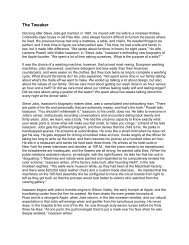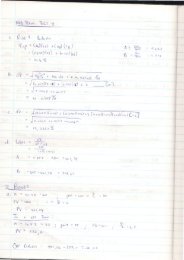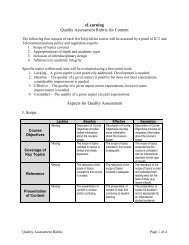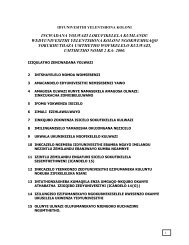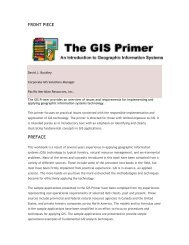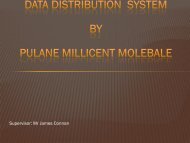Ecosystem Guidelines for Environmental Assessment
Ecosystem Guidelines for Environmental Assessment
Ecosystem Guidelines for Environmental Assessment
Create successful ePaper yourself
Turn your PDF publications into a flip-book with our unique Google optimized e-Paper software.
RENOSTERVELD<br />
Urban expansion is a problem in some areas. Urban development in adjacent areas can have a<br />
negative impact on the maintenance of an appropriate fire regime. When fires start they are often put<br />
out and not allowed to burn (resulting in dominance by slower growing, woody species, to the detriment<br />
of bulbs, herbs, and grasses). In other cases, fires are often deliberately set, resulting in too-frequent<br />
burns; slower-growing reseeding species will be lost from the system.<br />
Drainage of seasonal wetlands destroys alluvial renosterveld habitat.<br />
Trampling, such as by livestock, can result in the irreversible trans<strong>for</strong>mation of silcrete, ferricrete<br />
and quartz patches.<br />
Spraying of crops with insecticides may lead to the killing of pollinators of specialised plant species.<br />
The introduction of ostriches and other extra-limital game species into renosterveld can alter grazing<br />
regimes and result in trampling and damage to the biogenic surface. Ostriches are often introduced<br />
after wheat fields have been harvested and they can utilize remnant renosterveld patches heavily.<br />
Changes in the natural fire and grazing regimes (and the fine balance between them) will alter the<br />
species richness of all renosterveld types.<br />
Fields are often burned to remove stubble. These fires may impact on adjacent renosterveld if burnt<br />
too frequently.<br />
Renosterveld types are susceptible to invasion by annual alien grasses that replace bulbs. This is<br />
probably due to a mixture of eutrophication and herbicides, coupled with inappropriate grazing, but<br />
the details of this are not understood.<br />
Most renosterveld types are prone to soil erosion; physical disturbance of remaining intact examples<br />
of renosterveld should be limited to the minimum.<br />
When crops are sprayed (especially by aeroplane), renosterveld patches and their insect populations<br />
can be exposed to drift of herbicides and insecticides.<br />
Many landowners do not burn remnant renosterveld patches due to fear that fires may spread.<br />
Managed burns must be carefully controlled.<br />
Many of the non-toxic geophytes and annuals are vulnerable to grazing pressure by domestic stock<br />
in the first two years after a fire.<br />
What are the “bottom lines” and non-negotiables<br />
No more trans<strong>for</strong>mation is desirable in areas with intact, high quality vegetation. Habitat conversion<br />
must be avoided and strongly discouraged in threatened renosterveld.<br />
Plans to trans<strong>for</strong>m renosterveld should always be preceded by a botanical evaluation. Small<br />
remnants (~1 ha) can be very important <strong>for</strong> the conservation of individual species and achieving some<br />
pattern targets. However, in order to be functionally viable,<br />
larger patches should be within 500 m of each other and The Endangered geometric tortoise Psammobates<br />
connected by pollinator-friendly terrain.<br />
geometricus: a renosterveld endemic.<br />
It is critical to maintain pollinator-plant associations and<br />
pollution by herbicides, fertilisers and insecticide spray<br />
must be minimised.<br />
Avoid perturbations (including grazing and all <strong>for</strong>ms of<br />
physical trans<strong>for</strong>mation) to silcrete, ferricrete and quartz<br />
patches.<br />
Appropriate fire regimes must be maintained.<br />
Alien species should be eradicated.<br />
Extra-limital game species should not be introduced to<br />
renosterveld.<br />
BOTANICAL SOCIETY OF SOUTH AFRICA<br />
54 : RENOSTERVELD ECOSYSTEMS



